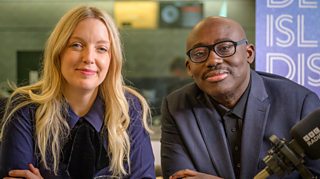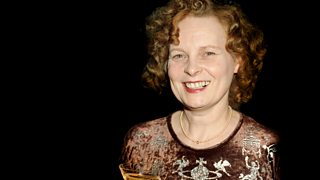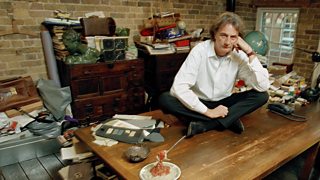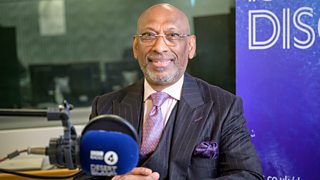Seven things we learned from Edward Enninful's Desert Island Discs
Edward Enninful is the editor-in-chief of British Vogue and the editorial director of Vogue in Europe. He's the first man to hold the post and the first black editor in Vogue's 100 year history across any of its 26 international titles.
His family moved to London from Ghana in 1985 and a few years later, when a teenage Edward was travelling on the Underground, he was spotted by a stylist for i-D magazine who asked if he’d like to become a model. After a short stint as a model, Edward was appointed fashion director of the magazine, the youngest person ever to hold this post at an international fashion title. In 2017 he became the editor-in-chief of British Vogue.
Here’s what we learned from his Desert Island Discs:
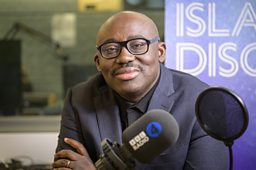
1. He owes his passion for fashion to his mother
“My mother was an incredible seamstress... a designer essentially and she had an atelier with 40 apprentices, as she called them, and every day was magical,” says Edward, thinking back to his childhood.
I just saw a man getting older who just loved his wife dearly and that really softened me
“Every day was sketching with her, watching women get dressed. You know, African dresses, head scarves to the sky, tiny waists - those incredible colour combinations, oranges and greens. And I just loved watching my mother work and watching all these incredible women, black women, just come in and out.”
“I think that really informed my styling because I can tell when a woman is happy. I can tell from a little wrinkle of the nose, or a little sort of intense look in the eye, but I learned all that from my mother.”
2. Edward’s father was strict but they became close in later life
Edward’s father Crosby was a Major in the Ghanian Army and Edward describes him as a “disciplinarian.”
Edward says: “He didn't quite know what to do with me. You know, like my sketches, I'll have to hide them when I saw him, and I was very soft.”
“I think that's what really happens to a lot of gay kids... You don't know what you are, but you kind of sense that you're different.”
Edward started studying at Goldsmiths University but dropped out to concentrate on his fashion work which led to a split with his father who threw him out of the family house. They were estranged for 16 years but reconciled after his mother became ill.
“My mother had a stroke and my father, had always been [to me] this kind of ogre in a way, and I just watched him look after my mother for 15 years. Literally he would be with her every day, looking after her, putting her to bed, you know, and I just saw a different man.”
“I just saw a man getting older who just loved his wife dearly and that really softened me. We’d go to my sister’s house for Sunday dinners and we'd talk more and more. And then when my mother passed I was awarded an OBE and I had a party [and] that night I just watched him surrounded by all my famous friends and he was just so happy dancing in his own world. So yes, we're really good now.”
3. His first issue of Vogue as editor was a love letter to Britain
Edward remembers the excitement he felt when the family first arrived in the UK from Ghana in 1985: “You know, the home of the Queen, the home of Boy George who I worshipped because he was gay.”
"I remember I turned to my brother and said, ‘Oh my God, it's all white people!’ I mean we'd never seen so many white people in our lives. You know, in Ghana we were the majority. Everybody was black: lawyers, doctors, the president.”
As an asylum seeker Edward’s father Crosby wasn’t allowed to work for the first few years so the family went to live with an Aunt and her two children in her flat in Vauxhall in South West London.
“But I remember being so happy squashed into those two rooms... watching Top of the Pops, reading Smash Hits, Number One magazine. I was soaking in everything... soaking in culture, beauty.”
Years later for his first Vogue as editor he revisited this arrival.
“It was a love letter to the country that took my family in, the country that literally gave me a life,” says Edward. But his intention was never to do a nostalgia piece, looking back at the past:
“I remember looking around at my friends and seeing that they weren't reflected in the magazine. When I say my friends, I mean people of different races, religions... socioeconomic backgrounds, size, age. They weren’t in the magazine and I just thought that's not even good business.”
“I just wanted to create a magazine that was inclusive, a magazine that was about diversity, where every woman would see themselves.”
Edward’s first issue in December 2017 featured the British model and activist Adwoa Aboah on the cover.

4. An experience on the Tube changed the course of Edward’s life
“A guy was staring at me,” says Edward. “I remember from Hammersmith all the way to Baker Street and I was so innocent, I was so naive, I just thought I had done something wrong.”
And somehow being in front of the camera, I just felt so confident, I wasn't so shy anymore
“At Baker Street he got up and said his name was Simon Foxton and said he was a stylist for a magazine called i-D and another one called Arena and would I model? And I was like, ‘Model? OK.’ I went home and I told Mum, I showed her the card and she said: ‘No, no, no! Not that business! It's full of funny people,’ whatever that meant,” says Edward laughing, “I think she meant gay people.”
“So, you know, I wore her down, I just wouldn't stop and then eventually she called Simon and I was on a shoot a week later and that really opened up the fashion world.”
And what was the shoot like?
“I just had to take my top off,” remembers Edward, “and sort of lie under a tree crawling with ants! But I was so happy I wouldn't complain. And somehow being in front of the camera, I just felt so confident, I wasn't so shy anymore.”
5. He was the youngest person to hold the title of fashion director at an international fashion title
Edward was just 18 when he was appointed to this position at i-D magazine in 1991. Fashion was still all about the glamour of the previous decade.
“We just wanted to show our reality which was Portobello Market, Camden Market, second hand clothes. You know we wanted to shoot each other in our flats.”
“I also discovered early on that there were these incredible women, my age, that they were calling the supermodels. I thought i-D had to be the one that represented them - we were all the same age.”
Somehow Edward managed to persuade them to work with him on a shoestring.
"Naomi [Campbell] would literally buy food for us. She would just get off a plane from a Steven Meisel [the renowned fashion photographer] shoot and she'd be in the back of a van - that's all we could afford - changing in the back of a van.”
“But it wasn't just Naomi, it was Linda [Evangelista], it was all of them!”
6. Edward’s experience of eye surgery was emotionally destabilising but stimulated his creativity
“I work with my vision and the idea of not being able to see is probably the scariest thing for me.”
The condition is retinal detachment and needs to be treated quickly otherwise there is a serious risk of permanent blindness.
“I remember the first surgery - they put a bubble in your eye, filled with air [that holds the retina in place] and then it gets smaller and smaller. After three weeks you're able to sort of look up, so you're literally [lying face down] looking down.”
“But in that moment I dreamt bigger than ever. I dreamt in Technicolour, I saw images that I hadn't seen before.”
“I was in darkness as well: I dreamt shoes, I dreamt covers. So even though it was the darkest period of my life, in a funny way, the brain went into creative overdrive like it did when I was younger. But it was probably the scariest moment of my life.”
7. One of his desert island tracks takes him back to that time
“Rihanna is a dear friend of mine. When I was going through my retinal detachments and feeling lost, feeling forgotten – because I didn’t work for two years – Rihanna would always call to check up on me and I would play this song because the lyrics are so beautiful, they reminded me of growing up in another place and her voice was so soothing.”
The song is Love without Tragedy/Mother Mary by Rihanna.

